Humanism is the aspect of giving value and importance to humanity over the divine beings (gods). Humanism gives humans value where no other system had before. Greek art illustrates humanism through its sculptures. Greek sculptures are very life-like as can be seen in the “Hermes and the Infant Dionysus” work. The body has shows that there was a lot of attention brought to the muscles and facial features by the artist. The stance that Hermes takes is very human, despite his status as a god. He stands in a pose so humanly that it almost looks as though he were right there in the room with you. In contrast, the “King Menkaure (Mycerinus) and queen” sculpture does not have a humanly stance. They are very rigid and do not look like they could be in the room with you. They look like statues, so they are evidently not life-like. Their facial expressions are not those of a person who you would ever interact with, as opposed to Hermes’ expression that looks like that of a real person. These aspects in the art show humanism by showing that the realism of the human body is of more importance than the actual aestheticism of the sculpture. In fact, even by making Hermes, a god, look like an ordinary human being is very different from most depictions of gods, because gods were not normally even remotely equated to humans.
Category: 11 AM Class
Humanism in Greek and Roman Art
Humanism is an outlook or system of thought attaching prime importance to human rather than divine or supernatural matters. Humanist beliefs stress the potential value and goodness of human beings, emphasize common human needs, and seek solely rational ways of solving human problems.
Greek Humanism also refers to the Greeks’ emphasis on the human body: on physical beauty and athleticism; the Greeks see physical beauty as literally “divine”, as godly. For the Greeks, all people can and do communicate with a god or gods; these gods exist very much in the real world, taking on the shape of humans, and even often having sexual relations with humans. This physicality reinforces the belief that human physical qualities are themselves an element of the divine. If the gods look like us, then we look like the gods; thus, our bodies are godly.
It was in the philosophical, artistic, and political writings of the ancient Romans that they found inspiration for their own move away from traditional religion and otherworldly philosophy in favor of a this-worldly concern for humanity. Rome was practical, not mystical. They were primarily concerned with whatever worked best and whatever helped them achieve their goals. Even in religion, gods and ceremonies which did not serve a practical purpose tended to be neglected and ultimately dropped, which added to the idea of humanism.
Unlike ancient Greek and Roman art, Mesopotamian and Egyptian art were meant to glorify the gods and the king. Greek and Roman art are different from Mesopotamian and Egyptian art as you can see in the pictures below. On the right is a Greek sculpture of a human man. He is shown to be very strong and masculine and shows off his body. On the left is a Mesopotamian carving of a god-like creature. Its a humans head on an animals body with wings. As you can see the two artworks are very different and focus on different ideas.
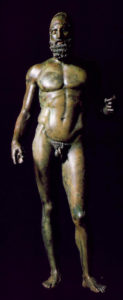
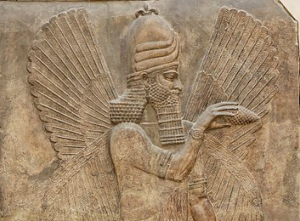
Humanism
The Greeks were the first to formulate the idea of Humanism, which is the belief that people play a central role in their society. This way of thinking majorly contrasts the Egyptian culture where everything was directed and governed by G-ds. The entire purpose of an Egyptian was praying to the G-ds or preparing for the afterlife. People were almost a nuisance and insignificant to the higher powers.
The Greeks emphasized the value of human beings and encouraged the idea of achieving greatness through philosophical thinking. Allowing some of the greatest philosophical giants to immerse, such as Plato. Another example of Humanism that the Greeks demonstrated were the Olympics. The very idea of humans achieving perfection and greatness. This drastic change in thinking is clear when analyzing Greek art and comparing it to Egyptian art. Below you can see the marble statue of the kouros (Egyptian) which hones in on displaying a sense physical human perfection showing how the Greeks viewed humans and their desire to attain this idealistic view of humans. As opposed to the Egyptian art beside it which show how G-ds played a great deal of importance throughout all stages of life. This particular image shows Hu-Nefer who was a scholar and is being judged by the G-ds measuring his heart. Notice how the Egyptian Gd all have animal character traits. They believed their G-ds had the attributes of animals showing power beyond humans, while the Greek G-ds were portrayed without any animal features and posed as the ideal human body.
Brooklyn Museum Part 1
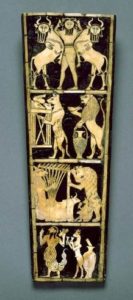
The front panel of the Great Lyre sound box is an example of Sumerian art from the Ancient Near East. The panel is divided into four different registers. These registers contain four scenes with figures (mostly animals) involved in various activities. Despite the rather rigid compartmentalization of the four sound box scenes, the overall effect of the front panel of the Great Lyre sound box is one of energy and dynamism. Such energy can be seen in the color of the figures and in curvy compositional lines.
The sound box is comprised of two different colors, a dark black and a light tan. These colors are caused by the medium of the panel. Dark black is the color of bitumen, which is used for the background of the panel and lines. Light tan is the color of the inlaid shell that is used for the bodies of the figures and objects. The stark contrast of light tan against a dark background adds a sense of dynamism to the figures. The figures seem to glow and hum with life. Furthermore, these lightly-colored figures are pushed closer toward the viewer, away from the black background, which gives the figures a sense of presence and energy.
The front panel of the Great Lyre sound box embodies energy in many ways. This energy can be seen not only because of the colors of the panel, but also through several compositional devices and lines. Such visual interest in energy is fitting for this piece, given that this sound box originally hummed with musical vibrations and the energy created by sound.
Museum visit 1 & 2
I thought it was really peaceful to walk around the museum and being in one after so long is kinda nice to be able to explore alone and take in the scale of the statues and art pieces.
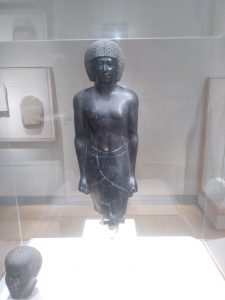
For the ancient Egyptian part of the project I choose was the Statue of a priest of Amun. what poked my interested was that it was made from diorite not from sand stone, and the details they had to carve into the head structure. The dimension are a bit bigger than what it should be used for thus breaking due to its weight and the brittleness at that scale.The art piece presents the importance of a priest in relation to their Gods which explains the use of the material. On the back side there are hieroglyphics with supposedly the value of the piece or a verse to keep track of hat the statue mean. My question for the statue would be where it would it be placed for all sides to be visible. I would assume there would be like an alter in a center hall for people to view it from all sides
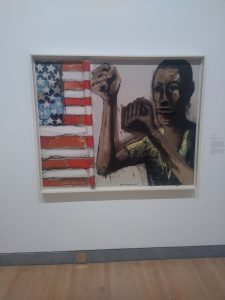
For the soul of a Nation I choose “Did the bear sit next to the tree” by Benny Andrews. the use of solid materials was the thing that allowed some of the ideas to pop out like the flag the should represent freedom for all is being rolled up and how the painted structure of the figure had real cloth and depict this solid object is fighting the American system. Also including the zipper used as a metaphor placing it as a mouth piece and how well it tie together with the themes. the painting was the weakest part and I thought it was to give more color and depth to it.
Brooklyn Museum: Ancient World & Soul of a Nation
Before going on this trip to the Brooklyn Museum I was a little hesitant. I had not been there since elementary school and I thought it would be boring. However once I got to the museum and started going through the exhibits I found myself pleasantly surprised, I was enjoying my time and did not realize I had been there for a couple hours. I ended up really liking the experience and I felt inspired to create some art of my own. There were several pieces that touched me but here are the once I chose.
Part 1: Ancient World
The Ancient Egypt exhibit had plenty of interesting pieces some of which reminded me of things we went over in class. Some being fancy well detailed jars that held black eyeliner like discussed in class the description said it was used for both male and females to highlight the eyes, reduce sun glare, and repel flies. Many statues and artifacts were astounding as well but what stuck me the most was the Coffin of the Lady of the House, Weretwahset which was part of the exhibit called A Woman’s Afterlife: Gender Transformation in Ancient Egypt. I chose this piece because I wasn’t aware that ancient Egyptian’s believed that after a woman’s death they had to temporarily turn into men in order to make rebirth possible. This was because ancient Egyptians believed that woman had a biological barrier to the afterlife. Ancient Egyptians thought that men created the fetus and passed it to the woman through intercourse thus rebirth was not possible for women in the afterlife. So what they did was temporarily turn women into men. They did this by having a priest recite spells using male pronouns and using colors that were for men. Formal analysis of the Coffin of the Lady of the House, Weretwahset color plays a big role as mentioned above. Here we can see that on the coffin the women has red skin her face, neck, arms and feet are all red. But in the cartonnage the women has yellow skin which represented the skin of a goddess made of gold showing her going back to being a woman. There are other colors as well her white dress, gold jewelry, black hair. There are some hieroglyphics. The coffin with red skin is bigger in scale than the car tonnage with yellow skin. There appears to be no empty space all very detailed. Some possible Egyptians gods are on the coffin as well. This relates to what we discussed in class for it represents the afterlife.
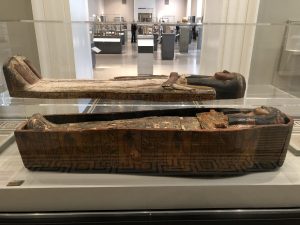
Part 2: Soul of a Nation
Soul of a Nation: Art in the Age of Black power is an exhibit that contains art work from 1958 – 1983. This exhibit focuses on the “complex work of Black artists who – at a time of dizzying political, social, and aesthetic revolution – produced some of the most innovative and electric art of the twentieth century.” (Brooklyn Museum) The description also mentions that these artworks were made “during a struggle of liberation” referring to systematic discrimination and racial violence of the 60s even though some advancements in Civil Rights had been made. The artwork that stuck me the most was Benny Andrews “Did the Bear Sit Under a Tree?” I chose this piece because of its incorporation of materials with oil paint. I was astounded by its meaning and how the materials added texture to the piece making it look three dimensional. Formal analysis there is a mixture of bright and dark colors in the painting. It can be seen in the shirt how it adds black and darker shades of green to create shadows and contrast. Within the shirt we can see there is real fabric beneath the oil paint. The mouth is made of a zipper adding a sense of expression to the face of disappointment. The flag is made of rolled up fabric adding three dimension which can also be seen o the nose. His fist are raised in anger towards the flag. The flag is also smaller in size compared to the man. The man also takes up most of the space, the main focus of the painting. Some semi straight lines can be seen in the arms and flag. Colors like red, blue, white, grey, green, brown, back can be seen. This relates to the exhibit because the author is reflecting on the Civil Rights protests in the 60s and states “It is a Black person who is shaking his fist at the very thing that is supposed to be protecting him [the flag] and the he’s operating under.”
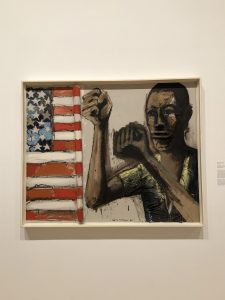
Unit 1 Summary
We have come to the end of Unit 1, time really does fly. In unit one we learned about critical pedagogy and formal analysis. To recap Pedagogy of the Oppressed was a book written by Paulo Freire in which he discusses the flaws in the education system and proposes the use of critical pedagogy. One of the flaws Paulo Freire explained was the Banking Model. In which students were viewed as empty containers that were filled by teachers who had all the power and left little to no critical thinking, thus encouraging critical pedagogy. This unit also discussed formal analysis. Which is a method used to interpret art by questioning and closely examining the physical piece of art through the different components of formal analysis. The different components are color, line, scale, space, and mass. The overall use of these elements is called composition. Although these are two separate topics in a sense they relate to each other. Both critical pedagogy and formal analysis encourage you to thoroughly examine thing and to think critically. I can see how formal analysis has helped me. Before when looking at an image, questions would pop into my mind however now I think more of it and I pay closer attention to details.

Brooklyn Museum Assignment
Upon walking into the Brooklyn Museum, which by the way was free with my BC Id, I was overwhelmed with the amount of artwork on display. Having never visited the Brooklyn Museum I was pleasantly surprised to find such interesting exhibits. I especially enjoyed those of the Egyptian galleries and Soul of a Nation. Using what I have learned, I had a whole new perspective on viewing art.
One specific piece of art really stuck out to me when visiting the Museum. A statue of a woman whose asking was red skin and what seemed like male facial features. Before reading the brief description of the artwork I began to use formal analysis to determine the different elements of the piece. The statue had a coffin like shape and was covered in hieroglyphics. I assumed that the coffin like statue was telling the story of some kind of after life of whomever the woman was. Using previous knowledge of the Egyptians great interest in the afterlife, I came to the conclusion that the writing has to do with the woman’s journey. After creating my own ideas of the artwork I of course read the description of the piece. The statue indeed was a coffin of a woman and the writing was the story of how a priest transformed the woman into a male so that she could have the ability to the idea of rebirth. Ancient Egyptians believed that a male was necessary for the process of birth and rebirth. Formal analysis help me understand the complexities of the piece and how to full appreciate its value much better than I did before.
My most enjoyable experience at the Brooklyn Museum was the Soul of a Nation exhibit. As much as I enjoyed the ancient world art the Soul exhibit was more of my style. As I entered the room I was pleased to see the many beautiful and moving images inside. The artwork that caught my attention immediately was that of Carolyn Lawrence Black Children Keep Your Spirits Free. The reason I chose this piece was for its vibrant vivid colors and detailed lines of the people within the picture. The different elements used to describe its meaning, it was truly and eye catcher. The representation of the children laughing,playing and playing music was so peaceful and innocent. Using from what is going on in today’s world I see how the artist is trying to make the point that no matter what color the children are just children. They are peaceful and bring peace to those who protect and observe. I am in awe of the beauty that this artwork brings in besides the actual colors. It was really one of my favorites.
My experience at the Brooklyn Museum was one of many surprises. Before coming I had no expectations and had no idea that I was going to enjoy it so much. The pieces I observed showed me the more meaningful side of art. How using simply paint and clay could impact and tell such detailed stories using zero words. Using what we learned has deeply changed how I now view and understand art. It has given me a new perspective on art and I am forever grateful it did.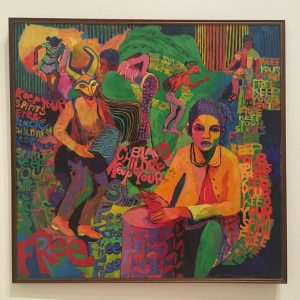
Brooklyn Museum Formal Analysis
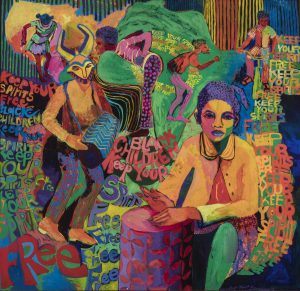
Painting Name: Black Children Keep Your Spirits Free (1972)
Artist name : Carolyn Lawrence
On initial sight of the painting Black Children Keep Your Spirits Free,1972 by the artist Carolyn Lawrence, it jumps at you with a bold range of colors. The acrylic paints provide vibrant edges and help separate the painting into sections without breaking off of the bigger image. It looks to be a compilation of six human figures doing different actions. Attention can be drawn to the most frontal positioned girl using a drum-like instrument. The various bright colors along the clothing bring the eyes toward the face. One can describe the colors to move from left to right. Many of the brighter colors can be seen more towards the right side of the painting compared to the left side. This could be on purpose judging by the palette of colors from one side to the other. The text spread out through the background say “Keep Your Spirits Free” move around the figures like a stream of water filling up the empty space. Along the top-side of the painting, there are stripes filling in the “sky” and what can be described as North America and Africa. This plays into the composition that could imply the influence from both countries. Each figure is performing a different action and seem to reflect off of “black” culture. The varying colors of the text is like a riot of something. If it were in a more plain text, the words would’ve probably lost it’s eye candy from repetitiveness. The artist most likely only painted the words “Black Children” once in the center because it draws the least amount of attention yet the most when observing the different elements piece together when stepping back for a bigger picture. The painting spans 48 1/2″ x 50 1/2″ x 5 1/4″ and is displayed with the Soul of a Nation: Art in the Age of Black Power exhibition at the Brooklyn Museum. The scale of the painting helps bring out the colors as well as the text for a greater comprehension. The smaller details are easier to spot and the artist did a good job filling in the what would have been empty space with color and subtle meaning like the colored silhouettes of two countries.
Overall, this painting brings various elements together with color mainly. As observed, the palette of colors move slowly over the painting as the figures stand out yet blend into the words of “Keep Your Spirits Free” In the description of the exhibit, the artists step out to tackle on unjust social conditions by making art. This painting particularly show some insight that black people have culture and are just as human as everyone else in the world.
Brooklyn Museum Visit
The entire Egyptian exhibition was really beautiful, it consisted of a lot of sculptures and models of Egyptian life and objects. The artwork that captured my eye immediately in the midst of all the others was, the Statue of Queen Ankhnes-meryre II and Her Son, Pepy II (author Unknown). The Sculpture is of a Queen (Ankhnes) holding her son, Pepy II. Immediately the size of both is noticeable as Queen Ankhnes is at least three times the size of Pepy II. Pepy II is on Ankhnes’ lap and facing East, as Ankhnes is facing North. The size could be a symbol of how powerful the mother-role was as she would serve as not only the domestic role but also as a protector of the future generations of Kings/Queens. Her role as a protector can be observed as Pepy II “clasps” her hand, clasping being a sign of reassurance and presence of one and their protection. Pepy II’s feet also are on a block almost half the size of his mother, this could further represent his King stature and how he will always be on some sort of pedestal in relation to the other Egyptians. The direction in which they’re facing can symbolize how they own have their own focuses or visions- the Queen ensuring that she’s fulfilling her role as a mother to nurse her child and still “act as regent” and Pepy II, facing his own direction can symbolize his priorities or focus of being “king as a small child”. The fact that he was king so young can also be another reason as for why he is so small in comparison to his mother, since he is not yet very powerful. It is made out of Egyptian alabaster which has a yellowish-brown town. Alabaster is very easy for drawing and carving. The neutrality in color could show that maybe there was no large gap in importance nor dominance between the two at that specific time- in Egypt Red usually symbolized Males and their dominance, and Yellow was normally used for Women. Or the lack of color can simply show us that there may have been a lack of color resources for art when this was made.

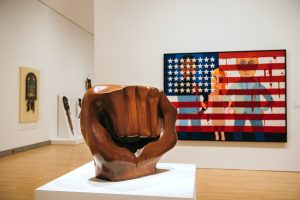
In Soul of a Nation there were very colorful paintings, some very colorful some abstract, some very simplistic, but all with a very powerful message. The artwork that seized my attention was the mahogany sculpture, “Black Unity” by Elizabeth Catlett. The sculpture is very large and is simply a sculpted closed fist, which has been established for unity- especially Black unity. The size of the sculpture is very big, which could represent a unity in activism for Black rights as many have come together to stand up for and reclaim their rights, especially in the last 50 or so, years. The use of making the fist Mahogany, a very deep brown, can be a literal representation of a Black hand. The sculpture is placed on top of a white square base, which could be used for contrast- to make the fist stand out greatly amongst everything else, almost as negative space- or simply for positioning, to re-imagine a world where Blacks are no longer subjected nor inferior to whites. The significance of this fist can extend largely, as it can be intended for an audience of whites as well, and make them feel powerless or serve as a reminder to make them remotely aware of racial injustices that have occured. When I was at the exhibit, I witnessed a lot of people, but a majority were white or tourists. Making this sculpture so big and noticeable, even the placement of it being in the middle of the floor with all the other artwork surrounding it can be a stamp or symbol for Black power and make everyone, especially the white people aware, as it is something you can’t miss nor ignore.






